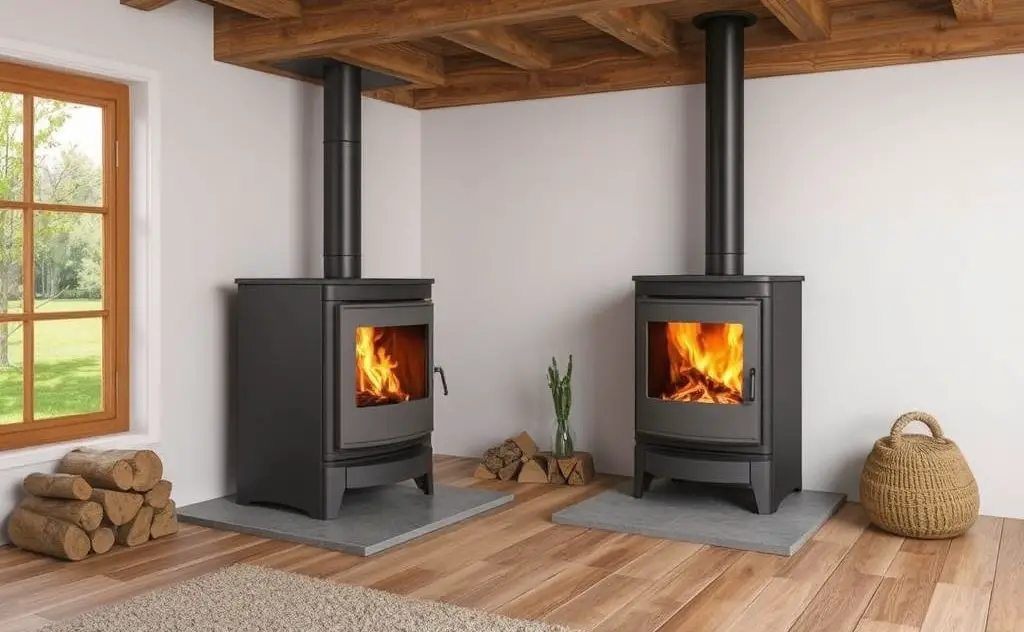The highest efficiency wood burning stoves achieve over 80% efficiency, providing optimal heat output while minimizing emissions and wood consumption.
Wood burning stoves have evolved into highly efficient heating solutions. Modern models deliver exceptional heat output while minimizing emissions and fuel consumption. This guide explores the most efficient wood stoves available today, their technologies, and how to choose the right one for your needs.

Top 3 Most Efficient Wood Burning Stoves
1. Blaze King King Ultra (85% Efficiency)
The Blaze King King Ultra stands as the most efficient wood stove globally with 85% efficiency (82% HHV). Its massive 4.32 cu.ft. firebox holds up to 91 lbs of wood, delivering:
- 40+ hour burn times on low setting
- 703,390 BTUs of available wood energy
- 12-16 hours of high heat output
This stove excels in cold climates and large homes. The catalytic combustion system ensures clean burns while maximizing heat extraction from every log.
2. HearthStone Green Mountain 80 (81% HHV Efficiency)
The GM80 combines cast iron construction with soapstone lining for exceptional heat retention. Key features include:
- TruHybrid combustion technology
- 3.1 cubic foot firebox fits 23″ logs
- Meets strict 2020 EPA emissions standards
Its soapstone construction absorbs heat during burns and radiates it gradually, providing consistent warmth. The large viewing window offers an impressive fire view while maintaining efficiency.
3. Lopi Evergreen with NexGen-Hybrid™ (80% Efficiency)
Lopi’s NexGen-Hybrid technology blends catalytic and non-catalytic benefits:
| Feature | Benefit |
|---|---|
| Three-stage combustion | Lower emissions, higher efficiency |
| Wide BTU range | Better control from low to high heat |
| Cord wood testing | Real-world performance metrics |
This system delivers 50% greater heat output than standard non-catalytic stoves with longer burn times.

Understanding Wood Stove Efficiency Ratings
Manufacturers use two efficiency measurement methods:
HHV (High Heating Value)
The EPA standard accounts for 19-24% wood moisture content. This reflects real-world conditions and actual heat transfer to your home.
LHV (Low Heating Value)
Assumes 0% moisture content, producing inflated efficiency numbers. While some manufacturers highlight LHV ratings, HHV provides more accurate performance expectations.
When comparing stoves, always check the HHV efficiency for meaningful comparisons. The best electric heaters that look like wood burning stoves can’t match the efficiency of true wood burners.
Advanced Combustion Technologies
Catalytic vs. Non-Catalytic Systems
Modern stoves use three approaches to maximize efficiency:
- Catalytic: Uses a ceramic honeycomb to reburn smoke at lower temperatures (500°F)
- Non-Catalytic: Relies on precise air injection and baffles for secondary combustion (1100°F+)
- Hybrid: Combines both methods for optimal performance across all burn phases
Three-Stage Combustion Process
The most efficient stoves like those from Lopi implement complete three-stage burning:
- Primary combustion of wood material
- Secondary burning of released gases with preheated air
- Tertiary combustion in catalytic chamber or advanced baffle system
This process extracts maximum energy while minimizing emissions and creosote buildup.
Choosing the Right High-Efficiency Stove
Key Selection Factors
- Home size: Match stove BTU output to your square footage
- Burn time needs: Catalytic stoves generally offer longer burns
- Fuel type: Hardwoods provide more BTUs per log
- Installation: Consider clearance requirements and venting options
For supplemental heating, consider the best indoor propane space heaters as an alternative.
Maintenance for Peak Efficiency
To maintain rated efficiency:
- Clean catalytic combustors annually (if equipped)
- Remove ash regularly to ensure proper airflow
- Inspect door gaskets and replace when worn
- Have chimney professionally cleaned each season
According to EPA studies, replacing an old stove with a new efficient model can reduce particulate emissions by 70% while using 1/3 less wood.
Efficiency vs. Heat Output
While efficiency measures how completely wood burns, heat output determines how much warmth reaches your home. The best built-in gas heaters can’t match the radiant heat quality of wood stoves.
Top performers like the Blaze King King Ultra achieve both high efficiency and massive heat output through:
- Large firebox designs
- Optimized airflow systems
- Heat exchange channels
- Thermal mass materials (soapstone, cast iron)
The Hearth.com forums provide real-world experiences from owners of these high-efficiency stoves.
